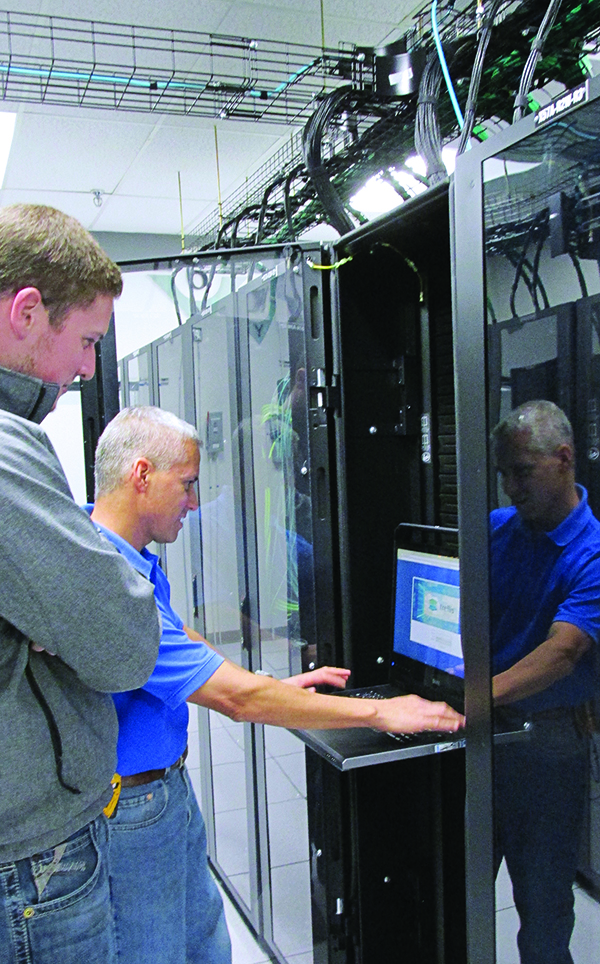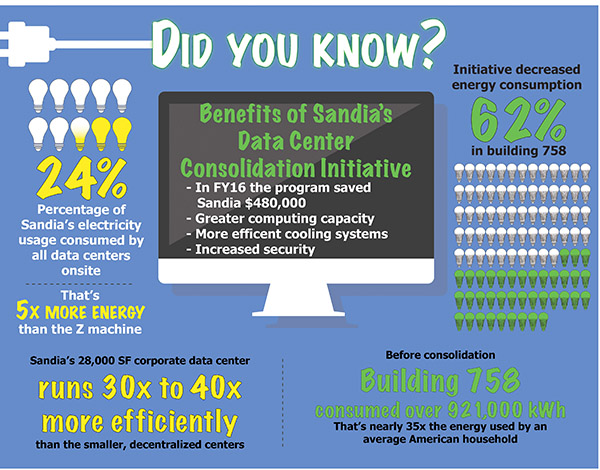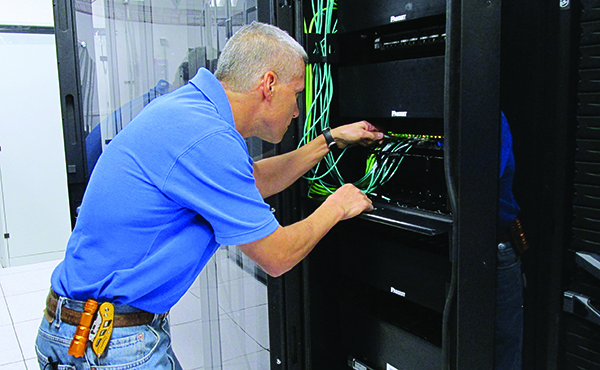Labs’ Data Center Consolidation Initiative

What are the largest constant energy users at Sandia? Sandians might guess the Z machine or the 858 MESA fab and lab. Both answers would be wrong. Data centers are five times more energy-intensive than these facilities, using some 24 percent of total site electrical energy at Sandia.
In 2013, Sandia assembled a team to embark on the Data Center Consolidation Initiative (DCCI) in response to a government directive to promote the use of green information technology. Among the DCCI members are Sam Jones (9342), Tim Seigler (9324), Matt Trujillo (9324), Carol Meincke (4855), and Dave Martinez (9324).
According to Sam, project lead of the DCCI, “This five-year investment will increase the efficiency of Sandia data centers through an intentional and strategic consolidation effort.”
A data center is any room with one or more servers that uses more than 20 kilowatts of energy. Data center consolidation involves decreasing an organization’s IT footprint through the adoption of more efficient technologies. At Sandia this involves combining the equipment of smaller data centers into a larger, more efficient system.

The most notable case study in how data center consolidation reduces energy at the Labs is the Bldg. 758 project. The building, in Tech Area 1, is used to conduct work in monitoring systems and technology. In 2013, it consumed more than 921,000 kilowatt hours, nearly 35 times the energy of an average American household. Through data center consolidation, energy usage in the building decreased by 62 percent. “The change was so dramatic the information was double-checked to ensure the meter was working correctly,” says Carol, the Facilities strategic planner for the DCCI team.
Sam points out that the benefits of data center consolidation extend beyond energy savings. “Consolidating data takes advantage of newer technologies to achieve both cost savings and greater computing capacity. We achieved energy savings and found a better way to do the computing portion because of evolving technologies. Basically, we are able to kill two birds with one stone.”
Benefits of Data Center Consolidation
When examining smaller data centers across Sandia, the DCCI team works to determine whether equipment could operate more efficiently if placed in the corporate data center.
“Smaller data centers are often constructed in buildings never meant to support them, such as office buildings,” says Carol. “Without the proper building efficiencies, more energy is lost and greater investments in equipment are required to cool the equipment.”
Smaller data centers are often constructed in buildings never meant to support them.
One unintended side effect of converting office spaces into data centers is the temperature fluctuations that occur from heat generated by the machines and the makeshift systems required to cool them down. Sam says employees in these buildings often suffer uncomfortably cold temperatures because the massive cooling units intended to cool machines are placed in buildings designed for people.
On the other hand, the 28,000-square-foot corporate data center is built to optimize efficiencies in energy use. Dave, engineering program/project lead for Infrastructure Computing Services, estimates the corporate data center runs 30 to 40 times more efficiently than the smaller ones scattered throughout Sandia.
Data center consolidation also increases security. Smaller data centers increase risks for data integrity as each center requires its own backup system.

Constant support available
“At the corporate data center, strong backup systems and a full uninterrupted power supply prevent data loss in case of system failure. The corporate data center also has constant support available,” says Dave.
The goal of DCCI is to consolidate smaller data centers that could be run more efficiently as one system. DCCI team members recognize that many people are reluctant to have their servers in different buildings, believing their data to be less secure. “However, we hope to create a paradigm shift in how consolidation is viewed,” Dave says.
From energy savings to increased information security, data consolidation is a win-win, says Dave. To that end, the resulting cost savings earned the project team a first-place award in the Labs’ Operational Innovation Program in the Cost Savings category. Data center consolidation saved Sandia $480,000 in FY16.
“We believe this is best business practice and evolution of where the technology is going,” Sam says.